West Virginia may be a small state, but it more than makes up for its size with its ecological diversity.
The high mountains in the east of the state and the foothills in the west create a broad range of climates and habitats to offer homes to a vast number of bird species.
We’ve counted 20 species of sparrow that can be seen in West Virginia. The majority of them are seasonal visitors, and many of them are fairly rare.
In this guide, you’ll learn when and where you can spot each species, as well as discover some top tips on how to identify these ‘little brown jobs’ that can sometimes be so challenging to distinguish!
Sparrows in West Virginia, Starting With The Most Common
Song Sparrow

- Species Name: Melospiza melodia
- Length: 4.7-6.7 in (12-17 cm)
- Weight: 0.4-1.9 oz (12-53 g)
- Wingspan: 7.1-9.4 in (18-24 cm)
The song sparrow is the most frequently seen sparrow in West Virginia by a long way! A whopping 45% of birdwatchers report seeing these common birds on their summer bird-watching checklists, and this only falls to 39% in winter.
Song sparrows are also the most common sparrow in North America and are easy to locate by the constant song that gave them their common name.
It’s this song that’s the easiest way to tell song sparrows from their brown-streaked relatives like Lincoln’s sparrow.
You can easily attract song sparrows to your backyard feeder by offering them tasty snacks like millet and sunflower seeds.
Eastern Towhee

- Species Name: Pipilo erythrophthalmus
- Length: 6.8-8.2 in (17.3-20.8 cm)
- Weight: 1.1-1.8 oz (32-52 g)
- Wingspan: 7.9-11.0 in (20-28 cm)
Eastern towhees are the second most commonly seen sparrow in West Virginia and are wonderful-looking birds. Their black, tufted crest, white breast, and red flanks make them the most colorful sparrow in the state. Weighing nearly two ounces, they’re also one of the biggest.
These native birds are much more commonly seen in West Virginia during the summer breeding season than in winter. Huge numbers of Eastern towhees migrate to the ‘mountain state’ to nest on the ground, often underneath shrubs and trees.
They lay up to 6 eggs, which take nearly 2 weeks to hatch, and then a similar amount of time for the young to fledge. Overall, quite a long nesting period compared to most sparrows!
House Sparrow
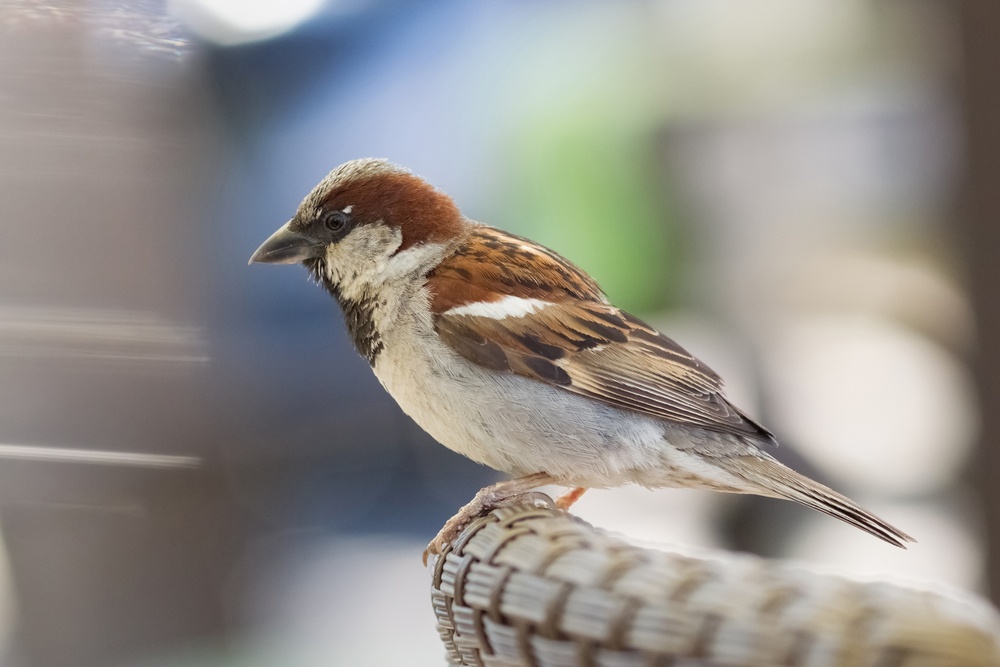
- Species Name: Passer domesticus
- Length: 5.9-6.7 in (15-17 cm)
- Weight: 0.9-1.1 oz (27-30 g)
- Wingspan: 7.5-9.8 in (19-25 cm)
House sparrows are the third most common sparrow in West Virginia, but they are not as common as they once were. The reason for their decline around the world is still a mystery, although various theories have been proposed.
With their black ‘beard’ on their light gray chest, the iconic male house sparrow is easy to recognize. The light brown females are less distinctive but are normally seen accompanying the males.
These social birds were introduced to the United States in 1852 from Europe and their presence has been met with mixed opinions. Because house sparrows don’t migrate, they can often dominate the nesting grounds of native birds.
On the plus side, house sparrows do have their charm, and their noisy flocks can bring cheer to dull winter days. These sedentary birds are present in all seasons in West Virginia, especially around human habitation.
Dark-eyed Junco
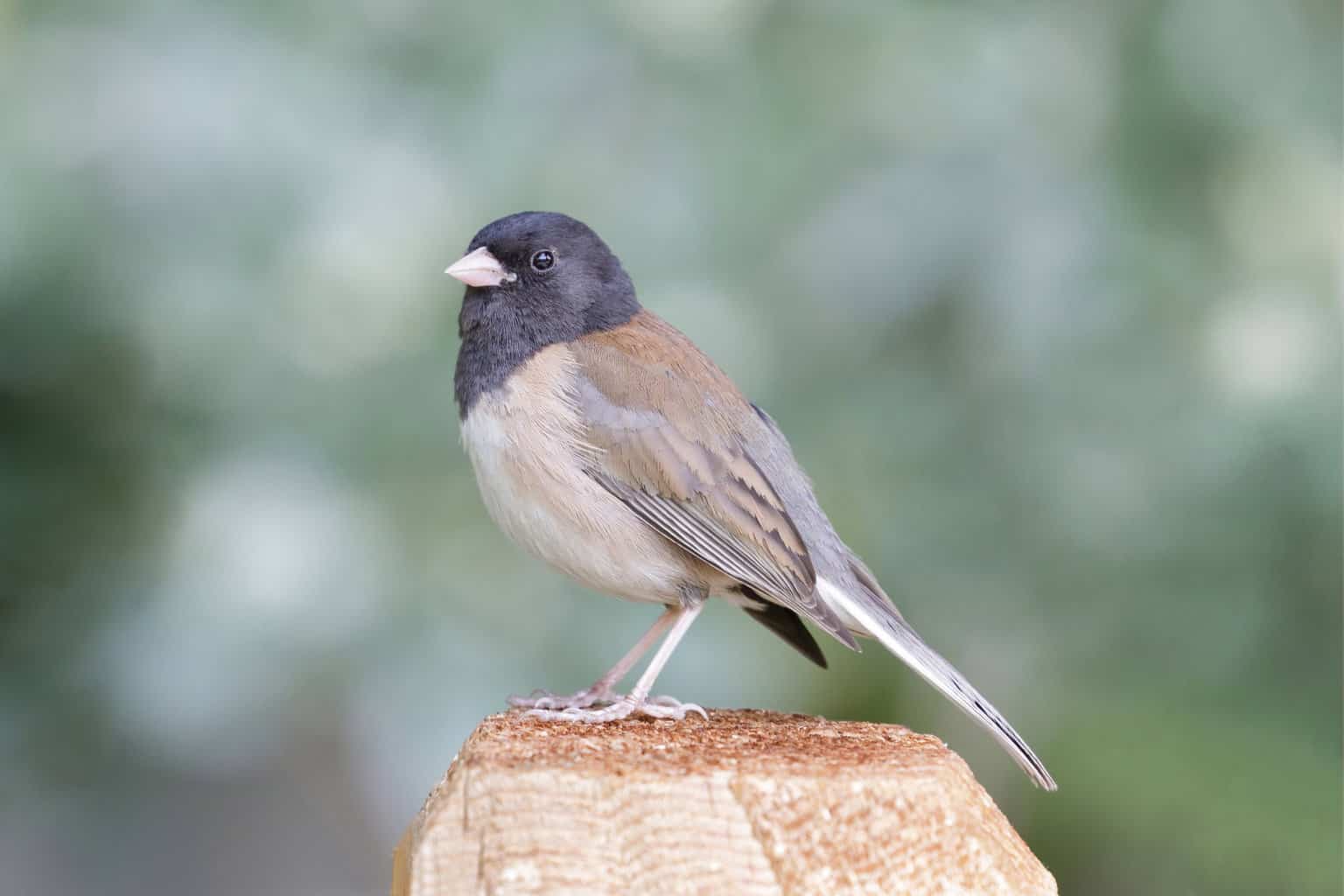
- Scientific Name: Junco hyemalis
- Length: 5.5-6.3 in (14-16 cm)
- Weight: 0.6-1.1 oz (18-30 g)
- Wingspan: 7.1-9.8 in (18-25 cm)
Although there are various sub-species of dark-eyed juncos across the United States, the ones that you’ll see in West Virginia will almost always be the ‘slate-colored’ variety. The males are well-described by this name, although females tend to display various shades of brown plumage, too.
Dark-eyed juncos are sometimes known as ‘snow birds’ because they seem to enjoy colder climates. The higher parts of the Appalachian mountain range is the only place you can find this subspecies breeding in the Southern United States.
In West Virginia, this means you can find these birds nesting in the higher mountains in the Central and Eastern parts of the state, but they can be found everywhere in winter.
Note that the black-headed Oregon dark-eyed junco is an extremely rare vagrant here, but might occasionally surprise bird watchers with an impromptu appearance!
Chipping Sparrow
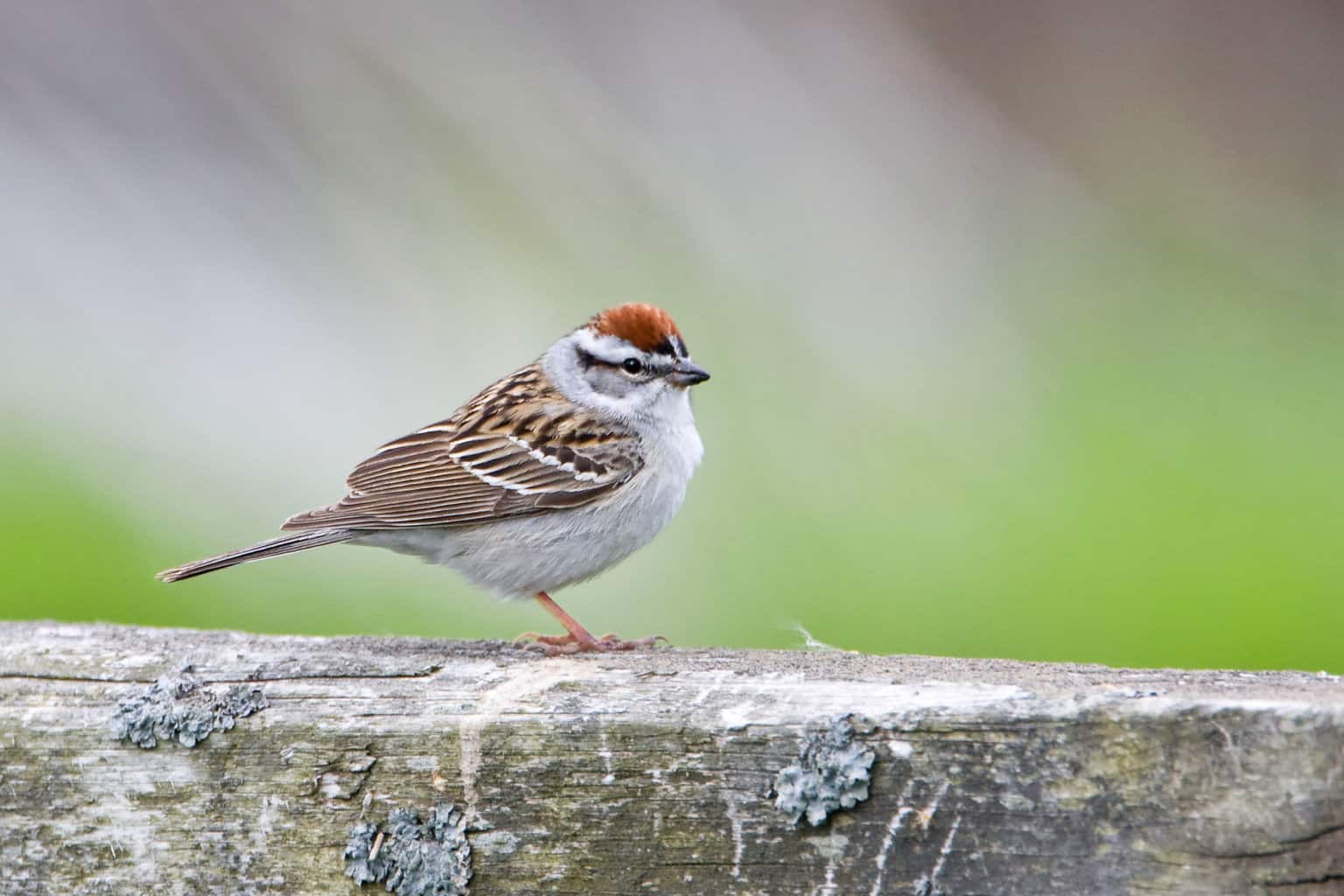
- Species Name: Spizella passerina
- Length: 4.7-5.9 in (12-15 cm)
- Weight: 0.4-0.6 oz (11-16 g)
- Wingspan: 8.3 in (21 cm)
Chipping sparrows are some of the most widespread sparrows in North America, with a migratory range stretching from Mexico to Alaska. They typically fly around in small flocks, often mixed with other sparrows.
These small birds are basically summer visitors in West Virginia, except for small flocks that may sometimes be seen in the southeastern parts of the state during the winter.
Chipping sparrows are closely related to clay-colored sparrows and Brewer’s sparrows, but can be distinguished by their highly pronounced eye line and rusty crown. Their trilling call is also one of the noisiest and most persistent in the woodland spring chorus, so it’s a useful one to recognize!
White-throated Sparrow
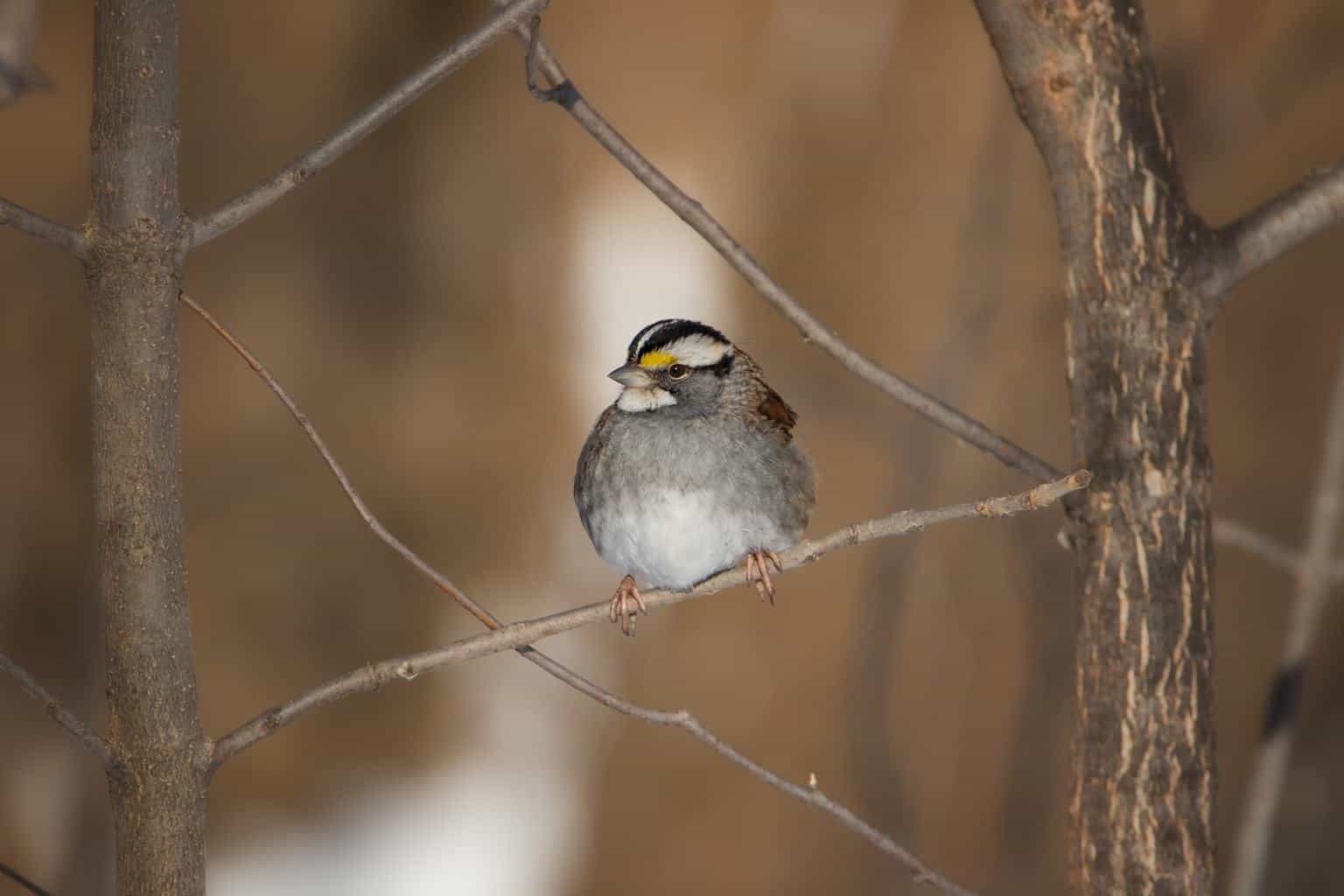
- Scientific Name: Zonotrichia albicollis
- Length: 6.3-7.1 in (16-18 cm)
- Weight: 0.8-1.1 oz (22-32 g)
- Wingspan: 7.9-9.1 in (20-23 cm)
The white-throated sparrow is fairly easy to recognize from its black and white (or sometimes tan) striped head, yellow eyebrows, and white throat and chin. They also have a distinctive melancholic whistle that can be remembered by the mnemonic: Oh-Sweet-Can-a-da!
These medium-sized sparrows are hardy critters and can be found throughout West Virginia during winter. In summer they nest mainly in Canada as well as a few territories in the Northeastern United States.
These endearing sparrows will readily accept food at backyard and woodland bird feeders.
Field Sparrow
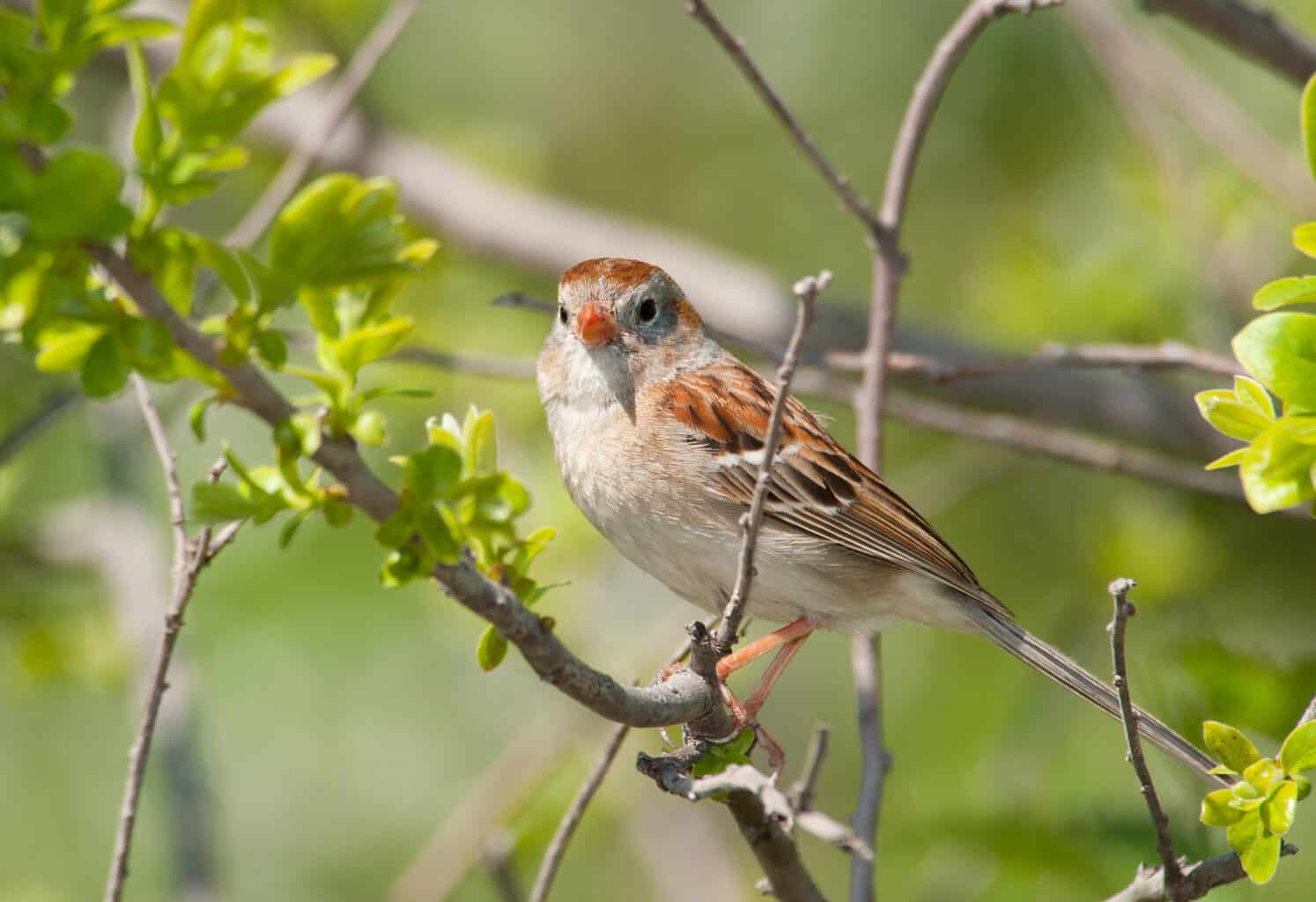
- Scientific Name: Spizella pusilla
- Length: 4.7-5.9 in (12-15 cm)
- Weight: 0.4-0.5 oz (11-15 g)
- Wingspan: 7.9 in (20 cm)
Although this medium-sized, gray, or rufous sparrow is fairly difficult to distinguish by appearance alone, field sparrows can be told apart from other similar-looking species by their loud, high-pitched call that sounds a bit like a bouncing ball coming to a stop!
Field sparrows are a common sight in West Virginia during the summer when large numbers of them come to breed here. Their grassy nests are built on the ground, and their young only takes about one week to fledge the nest.
You can help field sparrows through the cold West Virginia winters by offering them pumpkin seeds, sunflower seeds, and other oily grains at your backyard platform feeder.
White-crowned Sparrow
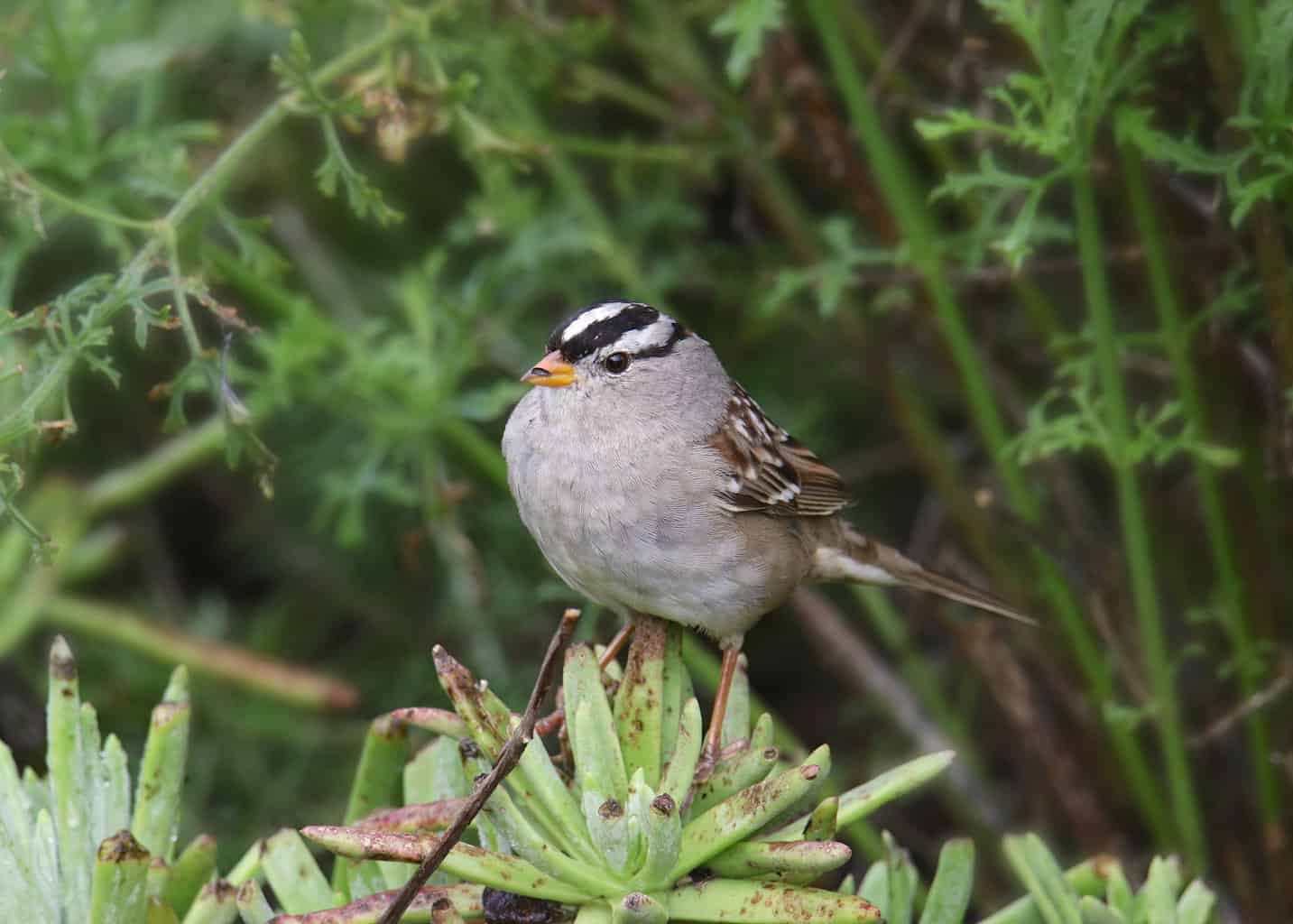
- Scientific Name: Zonotrichia leucophrys
- Length: 5.9-6.3 in (15-16 cm)
- Weight: 0.9-1.0 oz (25-28 g)
- Wingspan: 8.3-9.4 in (21-24 cm)
Now moving into the rarer sparrows of West Virginia, White-crowned sparrows are only reported by 3% of bird watchers during the winter and are altogether absent during the summer.
It’s during the migratory season, however, that you’re most likely to encounter these big sparrows when large numbers of them pass through West Virginia on their way to and from their nesting territories (most of which are in Canada).
The white-crowned sparrow is fairly easy to identify by the black and white stripes on their crowns, and their yellowish bill.
Since large numbers of them pass through the state in the spring and fall, you might have success attracting these birds to your backyard bird feeder for a refuel during their long-distance flights!
Swamp Sparrow
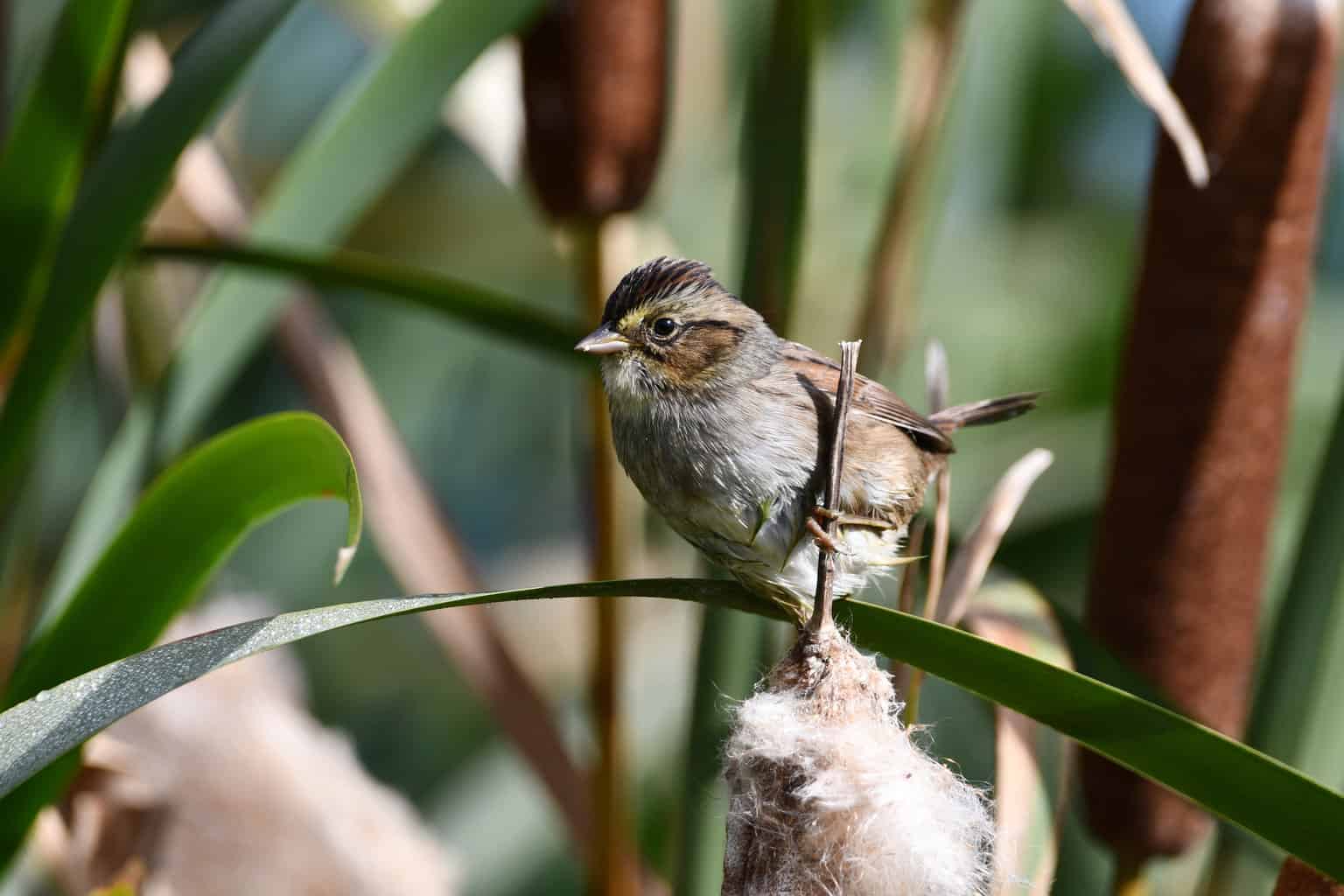
- Scientific Name: Melospiza georgiana
- Length: 4.7-5.9 in (12-15 cm)
- Weight: 0.5-0.8 oz (15-23 g)
- Wingspan: 7.1-7.5 in (18-19 cm)
The swamp sparrow is a small, endearing sparrow that likes to spend most of its time in wetland habitats. During the winter, however, they’ll sometimes occupy drier domains, especially weedy fields.
It’s at this time of the year that swamp sparrows can be spotted in West Virginia – the state lying at the center of this bird’s wintering grounds.
It can be challenging to spot these small, secretive birds in the wild. They vaguely resemble a song sparrow but have a darker underside and a smaller bill.
You may stand a better chance of seeing swamp sparrows by installing a bird bath or garden pond in your backyard so you can watch them from your window!
Savannah Sparrow
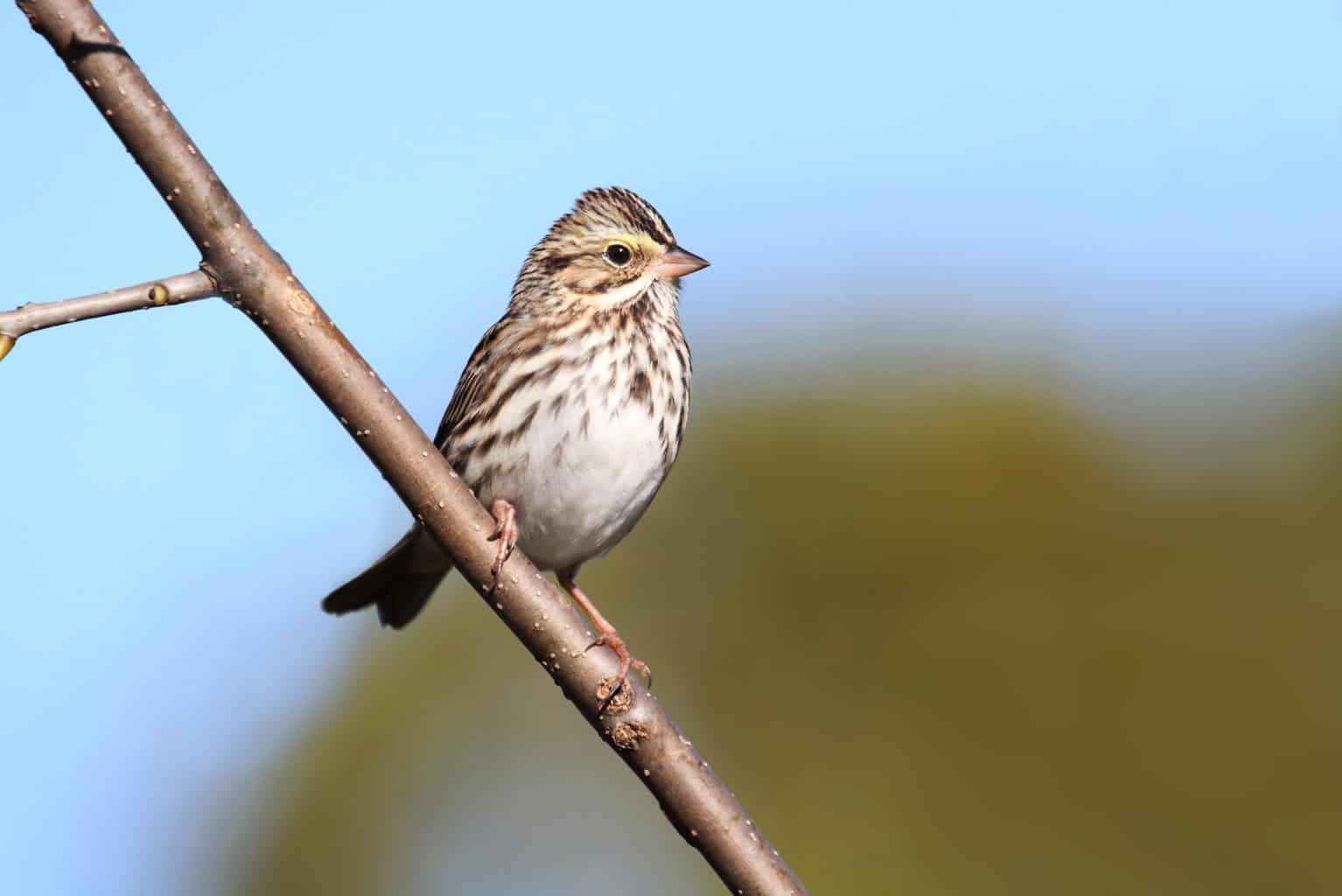
- Scientific Name: Passerculus sandwichensis
- Length: 4.3-5.9 in (11-15 cm)
- Weight: 0.5-1.0 oz (15-28 g)
- Wingspan: 7.9-8.7 in (20-22 cm)
Savannah sparrows are only spotted by about 1 in 50 bird watchers during the summer months and are absent altogether during the winter.
Savannah sparrows prefer nesting in open, weedy grasslands, marshes, and dunes, and will often fly to the top of tall weeds or fence posts when disturbed.
Although they look rather like song sparrows, they can be identified through a pair of binoculars by the yellow wash around their face.
Fox Sparrow

- Scientific Name: Passerella iliaca
- Length: 5.9-7.5 in (15-19 cm)
- Weight: 0.9-1.6 oz (26-44 g)
- Wingspan: 10.5-11.4 in (26.7-29 cm)
Fox sparrows are large, thrush-like sparrows, with broad wingspans and speckled chests. They even whistle and scratch about in undergrowth for food a bit like thrushes do!
Fox sparrows are the only species in their genus, meaning they don’t have any close cousins. The subspecies you’ll find here is the classic red-tinted, yellow-billed ‘Taiga’ form from which this bird got its name.
This Taiga subspecies has a large migratory range, extending from Georgia to Alaska. West Virginia is positioned at the northern edge of the fox sparrow’s winter range, meaning they remain fairly rare birds here.
Grasshopper Sparrow
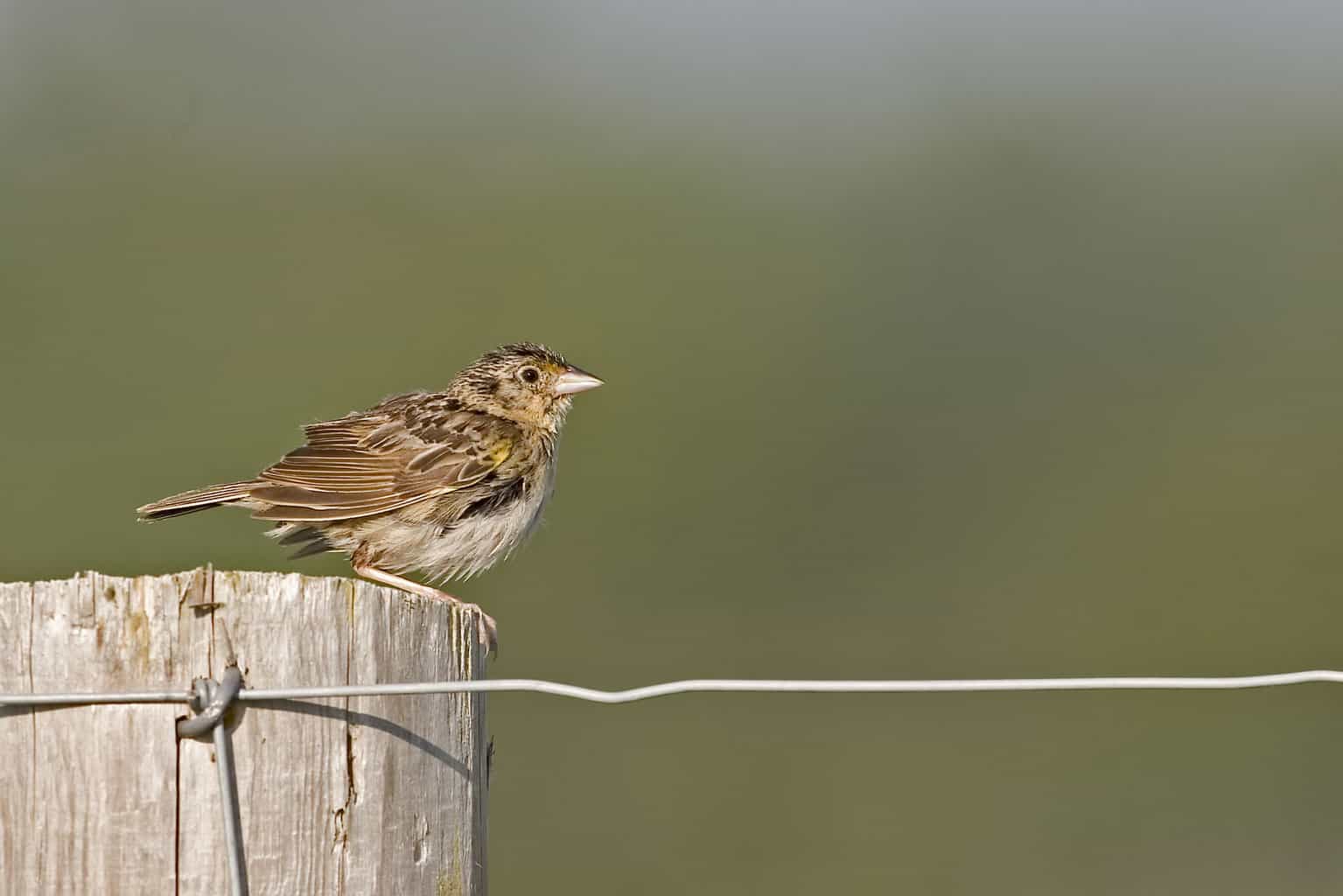
- Scientific Name: Ammodramus savannarum
- Length: 4.3-4.5 in (10.8-11.5 cm)
- Weight: 0.5-0.7 oz (14-20 g)
- Wingspan: 7.9 in (20 cm)
There have been few birds as badly hit by habitat loss and intensive agriculture as the grasshopper sparrow. This species was once common but has declined by 70 percent in the last 50 years.
Grasshopper sparrows are the most widespread members of the Ammodramus clan of sparrows, a group of tiny, shy birds that are normally found in grasslands. It can be told apart from its cousins by the lack of streaks on its breast that are present in other species.
The grasshopper sparrow not only sounds like a grasshopper but also loves eating them during the summer when they nest in dry grasslands. Learning this song is one of the best ways to glimpse this secretive bird.
Summer is the only time of year when you’ll find grasshopper sparrows in the south of West Virginia – these fair-weather birds spend their winters only in the Southernmost United States and Central America.
American Tree Sparrow
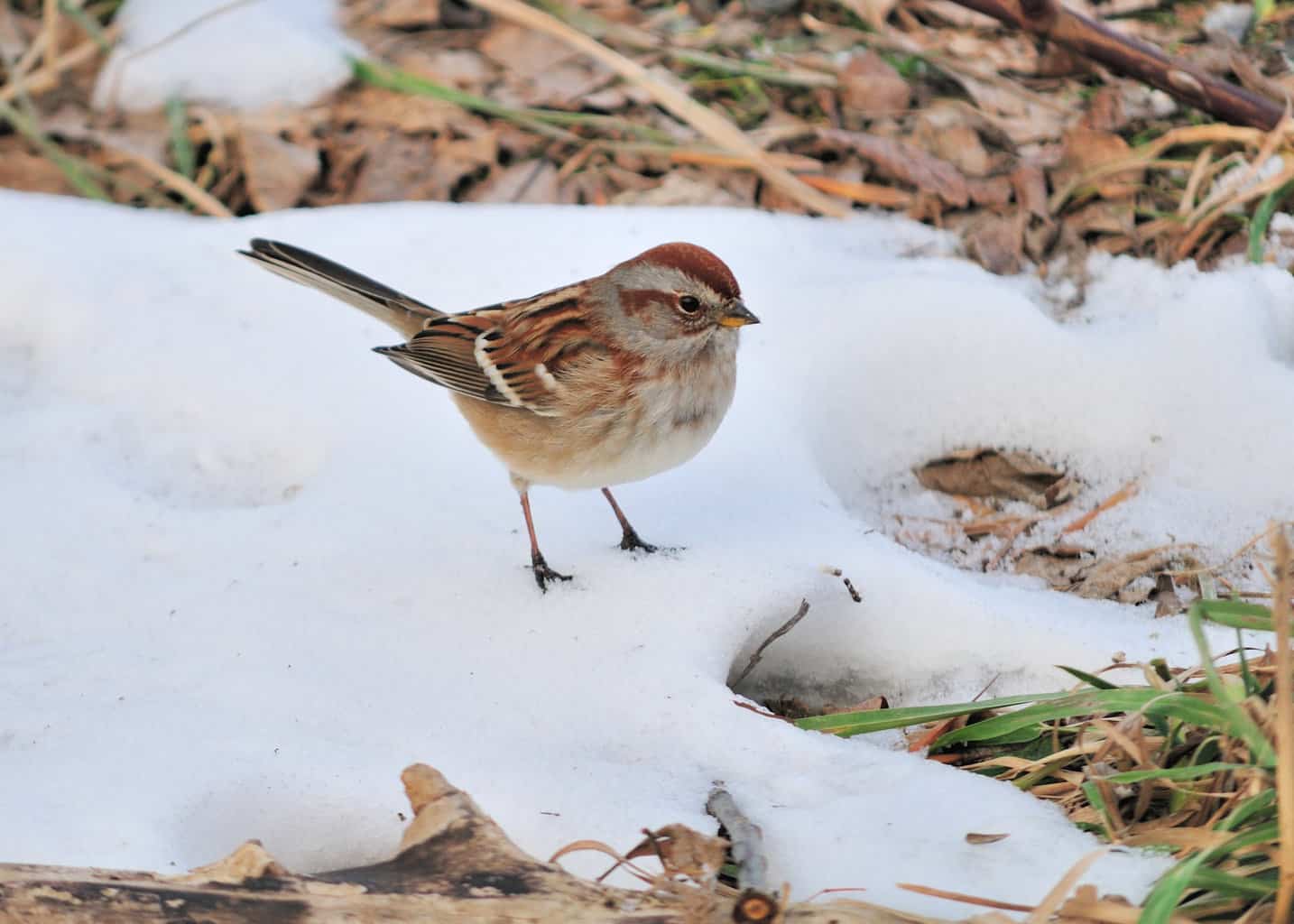
- Scientific Name: Spizelloides arborea
- Length: 5.5 in (14 cm)
- Weight: 0.5-1.0 oz (13-28 g)
- Wingspan: 9.4 in (24 cm)
The hardy American tree sparrow may be a common bird further north, but because West Virginia lies at the southern edge of their regular wintering range, you’re only likely to see small numbers of them in the north of the state.
American tree sparrows are most easily recognized by their rufous crowns and eye lines set against an otherwise gray head and throat. They’re slightly larger than the similar-looking field sparrow.
Despite their name, American tree sparrows are normally found near the ground. The misnomer about their habitat is due to them being named by early settlers who simply named this sparrow after the look-alike Eurasian tree sparrow that it reminded them of!
Lincoln’s Sparrow
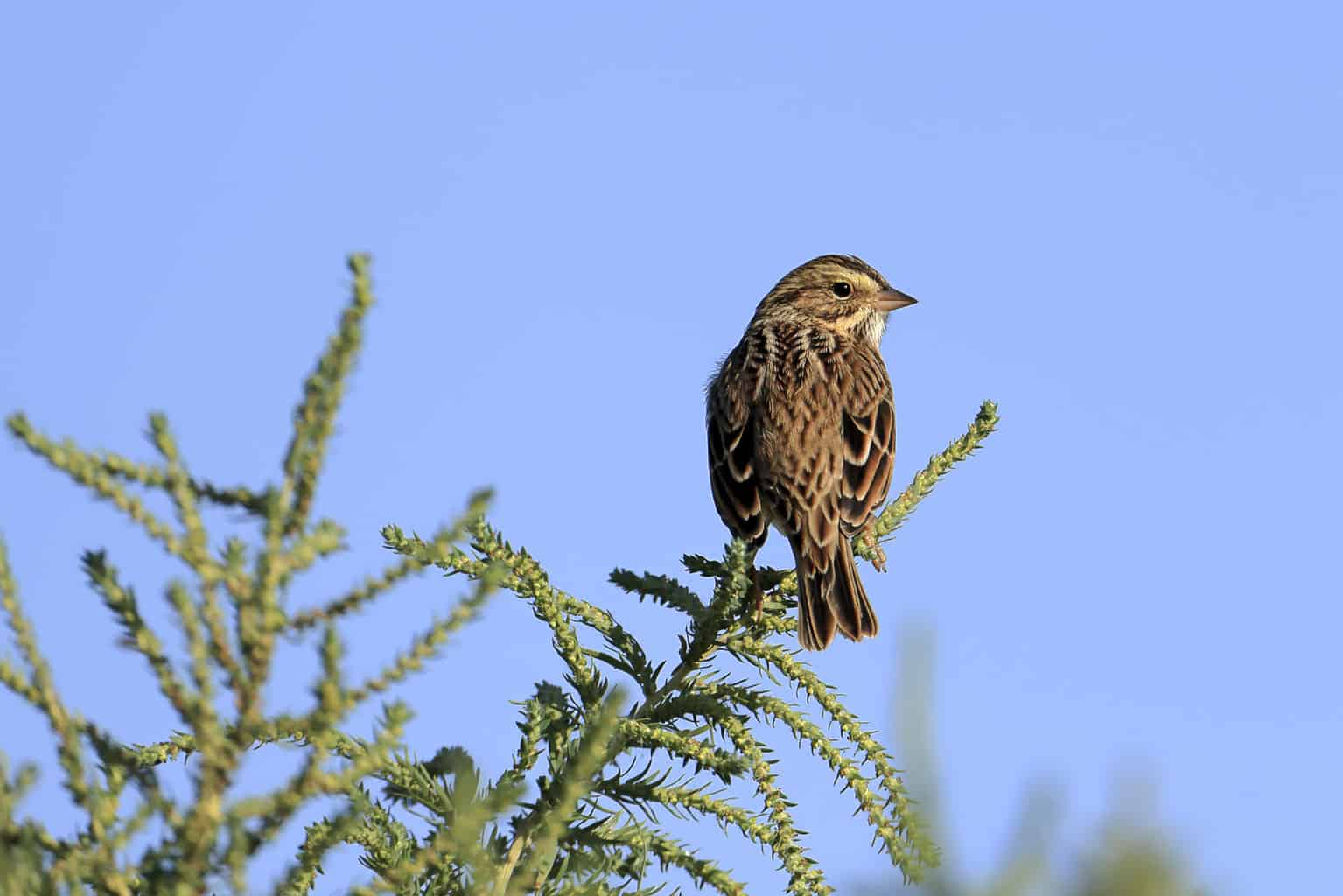
- Scientific Name: Melospiza lincolnii
- Length: 5.1-5.9 in (13-15 cm)
- Weight: 0.6-0.7 oz (17-19 g)
- Wingspan: 7.5-8.7 in (19-22 cm)
Lincoln’s sparrow is purely a passing migrant in West Virginia but is notable for one standout virtue.
While this bird may be fairly difficult to recognize by sight, they are renowned for their distinctive song which is surely one of the sweetest and most soothing of any songbird in North America.
Lincoln’s sparrows are a close relative of the song sparrow, but they are rather smaller in size, with a shorter tail.
Vesper Sparrow
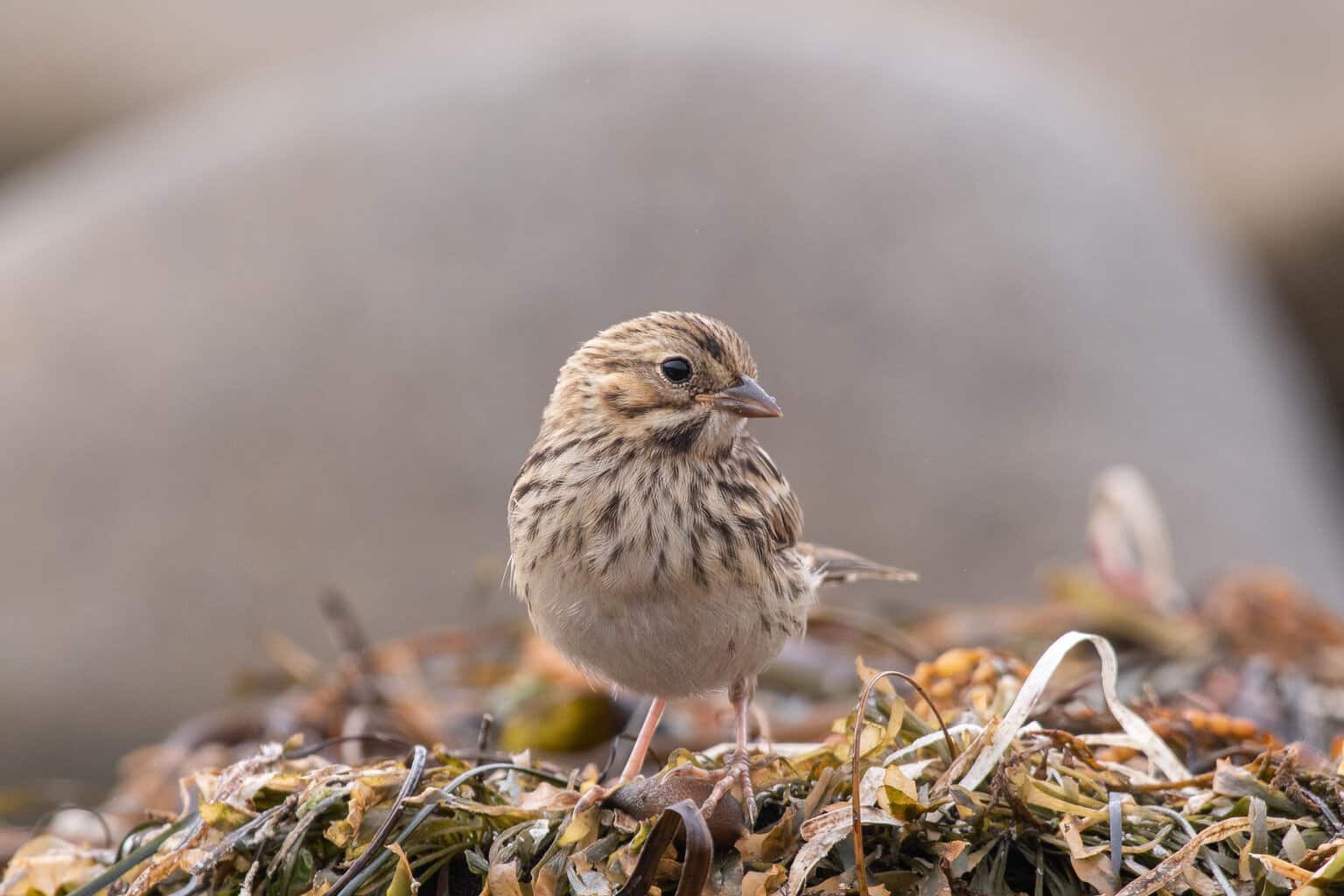
- Scientific Name: Pooecetes gramineus
- Length: 5.1-6.3 in (13-16 cm)
- Weight: 0.7-1.0 oz (20-28 g)
- Wingspan: 9.4 in (24 cm)
Most vesper sparrows overwinter in the far southeast of the US and breed in the north, making the states in the middle a mere transit zone.
West Virginia, however, is one of the few states of this region where small numbers of vesper sparrows settle to breed, attracted to the high mountains in the west of the state which have a similar climate to Southern Canada.
The vesper sparrow is similar in appearance to the savannah sparrow, but they’re slightly larger, with a longer tail, and without the yellow wash on their face. Like savannah sparrows, they can often be seen perching in the open on wire fences, and also often fly to treetops when disturbed.
Vesper sparrows numbers have declined by 37 percent during the last 50 years. This is mostly due to habitat loss in both breeding and wintering grounds. Modern farming practices, including pesticide use, hedgerow clearing, and early hay harvesting, have also been detrimental.
Henslow’s Sparrow
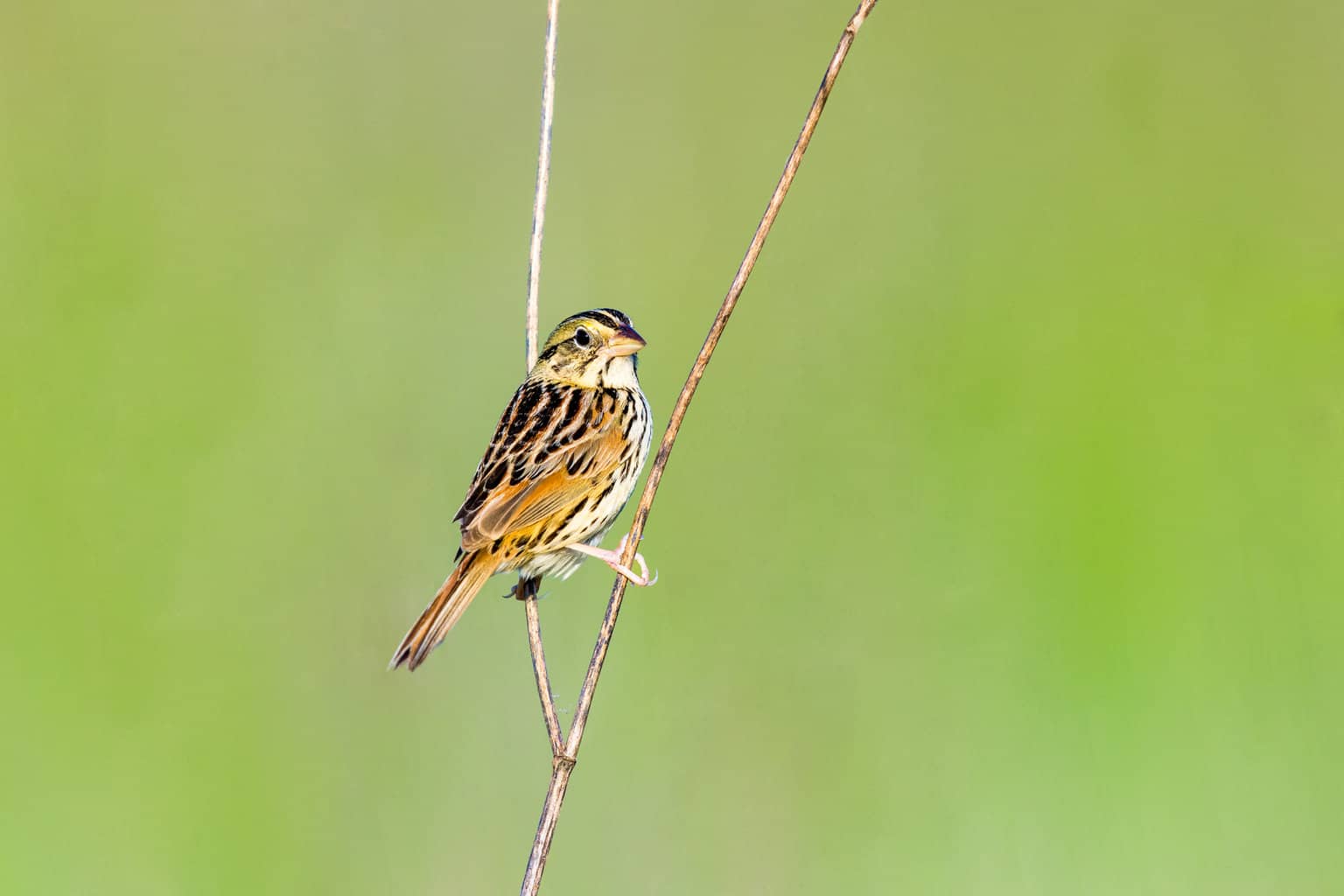
- Scientific Name: Centronyx henslowii
- Length: 4.75 – 5.25 in (12 – 13 cm)
- Weight: 0.5 oz – (14 g)
- Wingspan: 6-7 in – (15 – 18 cm)
Only seen by one in a hundred bird watchers in West Virginia, Henslow’s sparrow is indeed one of the most challenging of any New World sparrow to spot in the wild!
These birds seem to do everything to avoid detection. At only 5 inches long, they’re one of the smallest sparrows, their streaky appearance makes them blend in with their grassy surroundings, and they have the shortest song of any songbird in America!
To make matters worse for birders, Henslow’s sparrow is extremely stingy about using its wings, and prefers to run through the grass when disturbed rather than taking flight!
All in all this hard-to-spot sparrow should be considered a prized sighting. They’re most easily recognized by their yellow-olive-tinged head and massive bill.
Clay-colored Sparrow
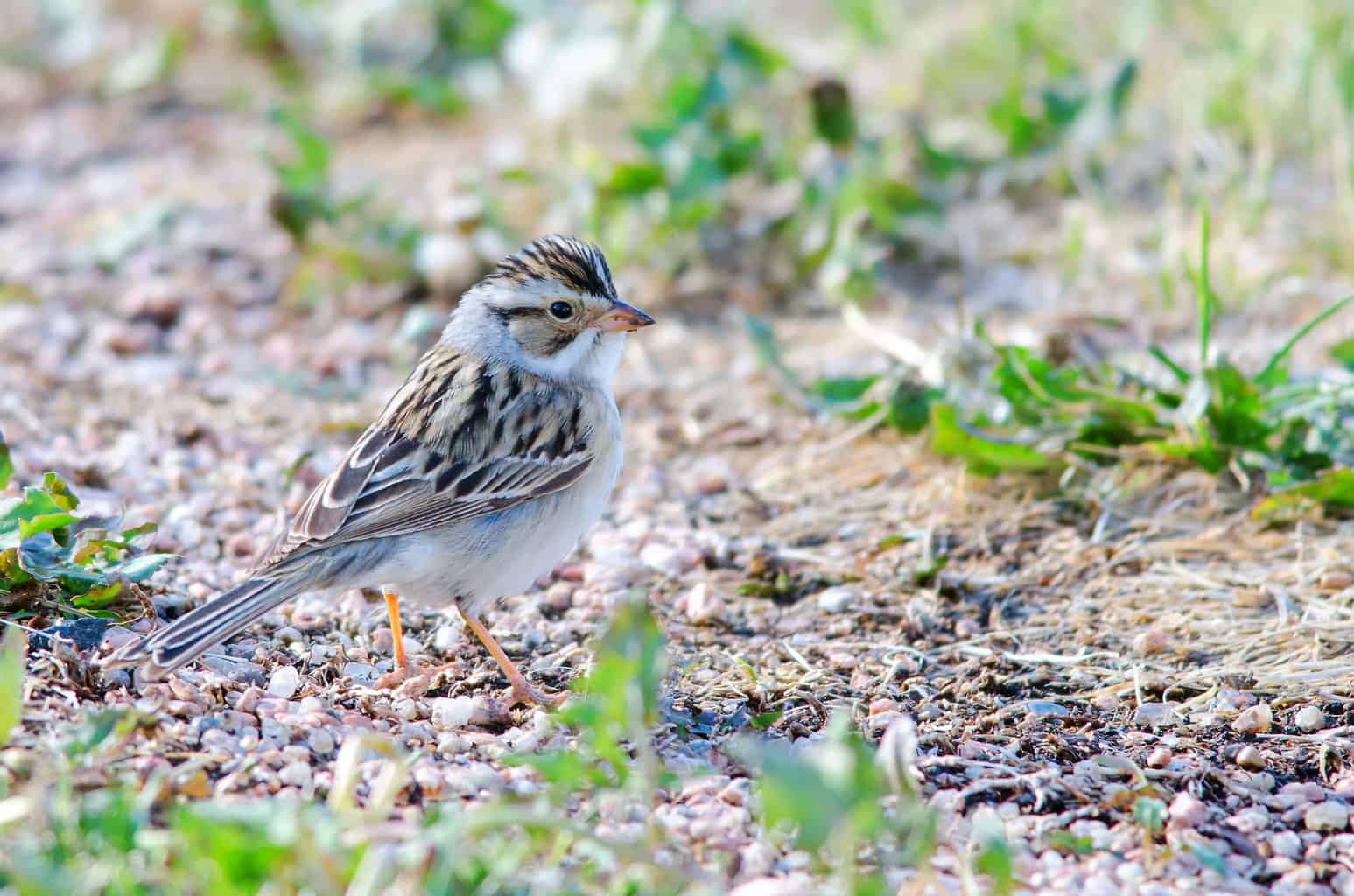
- Scientific Name: Spizella pallida
- Length: 5.1 – 6 in (13 – 15 cm)
- Weight: 0.42 oz (12 g)
- Wingspan: 7.5 in (19 cm)
Because the clay-colored sparrow mostly spends its winters in Central America and its summers in the central north of the continent, it’s merely a transient bird in most of the country.
It’s especially rare to see clay-colored sparrows this far to the east, although a few drifters may be spotted during the migration seasons.
The clay-colored sparrow only really deserves its name between August and March when they adopt a light brown-pinkish plumage. During the spring migration, however, they’ll be wearing their white breeding outfit!
- Sibley Guide To Birds, 2nd Ed
- Sibley, David Allen (Author)
- English (Publication Language)
Last update on 2024-04-27 / Affiliate links / Images from Amazon Product Advertising API
LeConte’s Sparrow
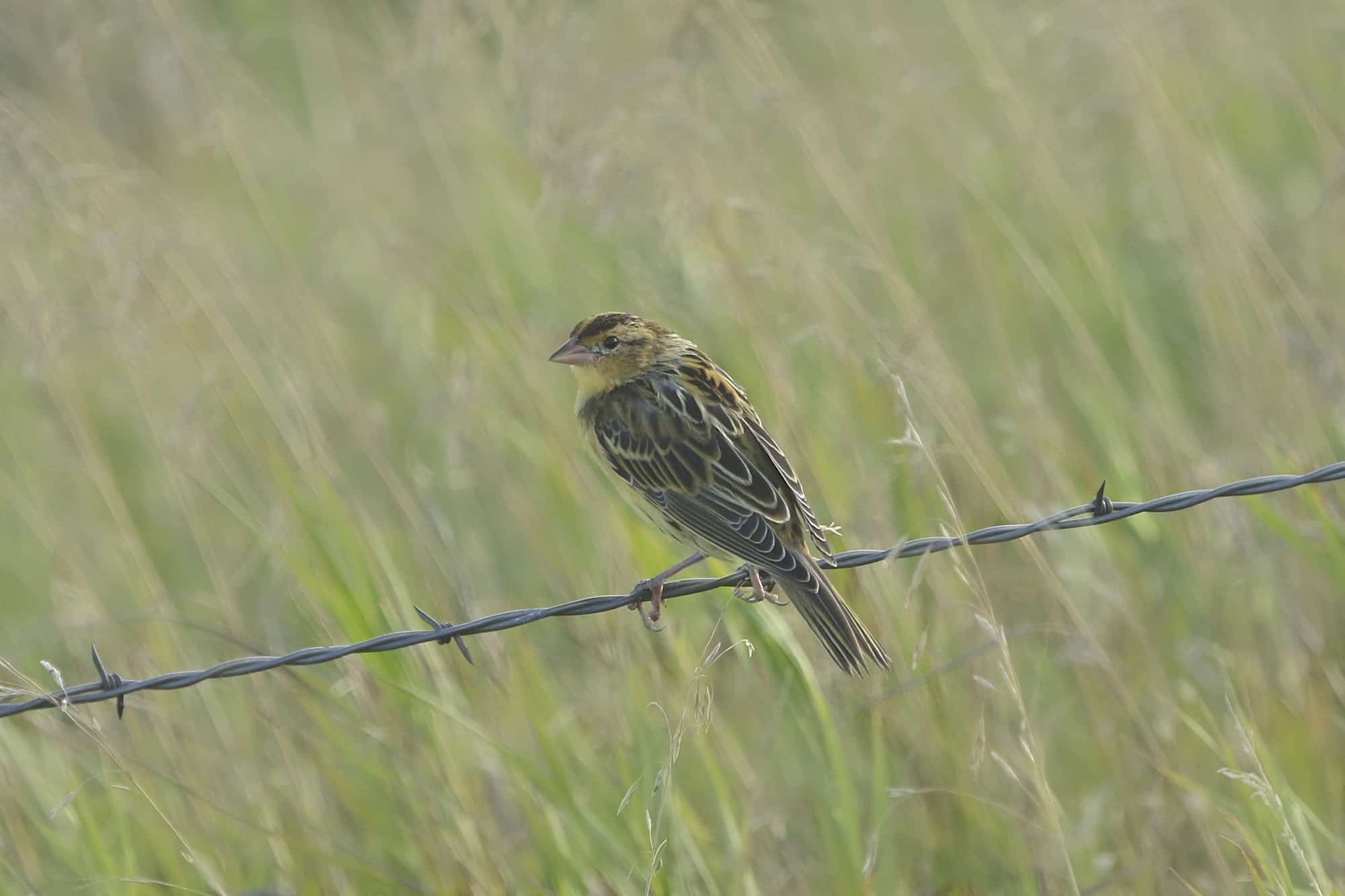
- Species Name: Ammospiza leconteii
- Length: 4.7-5.1 in (12-13 cm)
- Weight: 0.4-0.6 oz (12-16.3 g)
- Wingspan: 6.3-7.1 in (16-18 cm)
Leconte’s sparrow isn’t particularly common anywhere in North America, and it’s especially infrequent in West Virginia. They’re only ever seen during the winter on the western fringes of the state.
This species does, however, earn itself a place on the West Virginia Division of Natural Resources checklist, and was spotted in the 2019-2020 Audubon Christmas Bird Count.
A close cousin of the grasshopper sparrow, LeConte’s sparrow is slightly smaller, with more of an orange color and a narrower, smaller bill. They also prefer wetter habitats to grasshopper sparrows.
Like the other grassland birds in their genus, the survival of Le Conte’s sparrow relies on the preservation of their native habitats.
Nelson’s Sparrow
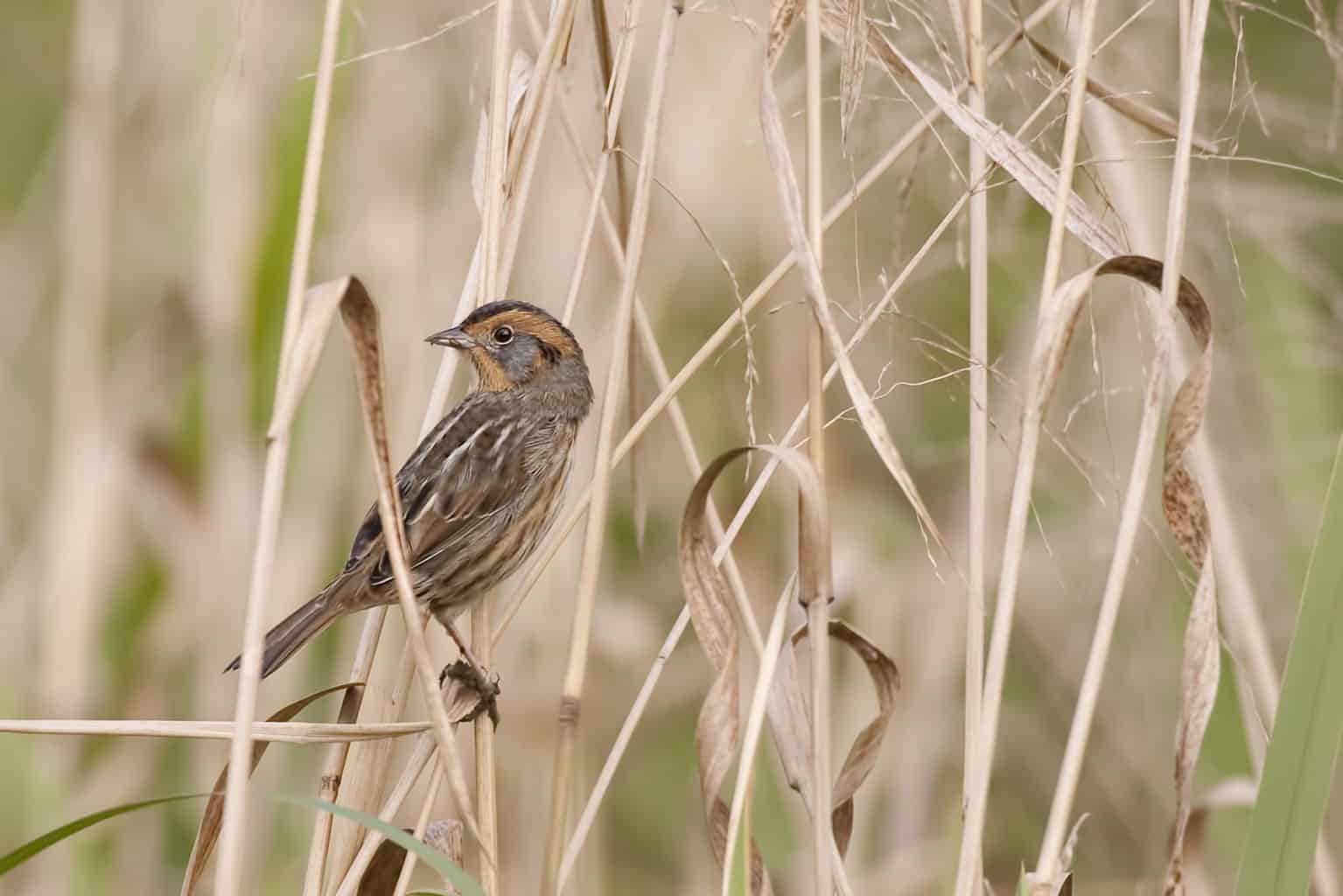
- Scientific Name: Ammospiza nelsoni
- Length: 4.3-5.1 in (11-13 cm)
- Weight: 0.6-0.7 oz (17-21 g)
- Wingspan: 6.5-7.9 in (16.5-20 cm)
Nelson’s sparrow is one of the most recently classified of all sparrow species. That’s because until 1989 they were thought to be the same species as the saltmarsh sparrow! Unlike their purely coastal cousins, however, Nelson’s sparrow sometimes migrates inland to nest in freshwater wetlands, too.
Although there have been no records of them nesting in West Virginia, some bird watchers have spotted them migrating through the state on their way back from more northwesterly breeding grounds in the fall.
Although they look a little like LeConte’s sparrow, they are larger, with a longer bill, and nest in even damper habitats than their cousin.
Lark Sparrow
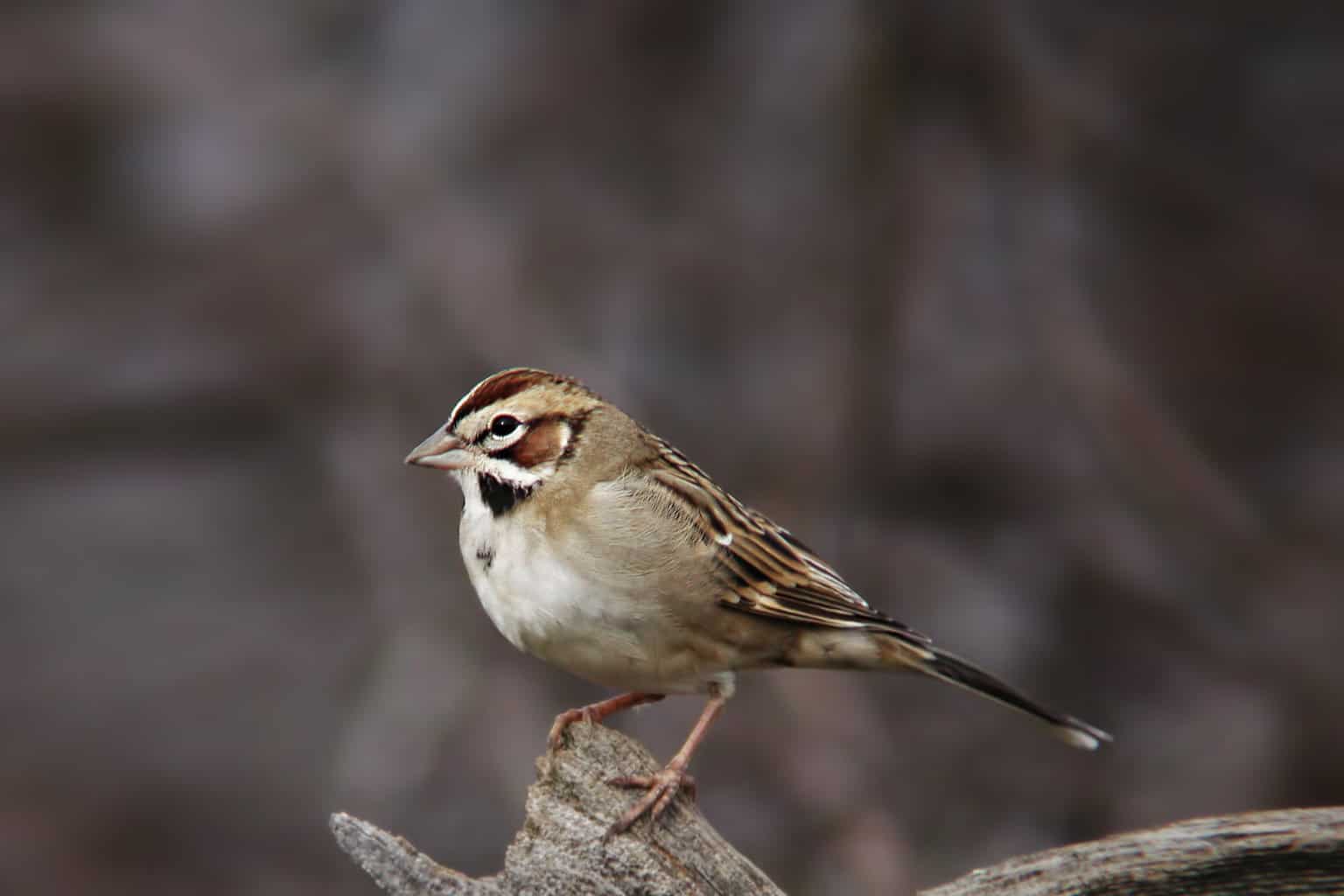
- Scientific Name: Chondestes grammacus
- Length: 5.9-6.7 in (15-17 cm)
- Weight: 0.8-1.2 oz (24-33 g)
- Wingspan: 11.0 in (28 cm)
Lark sparrows are extremely rare in West Virginia, and should only be considered an accidental vagrant in the state.
This large, striking-looking sparrow is, however, a treat to spot, and climate change could mean they’re seen more often this far east over the coming years.
If you do spot a lark sparrow in West Virginia, try to get a photo and report it to a bird monitoring authority such as ebird.org
Conclusion
There are at least 20 sparrow species you can see in West Virginia, which is quite an impressive diversity for such a small state.
More than half of the species, however, are fairly rare, and most are seasonal. Protecting and restoring native grassland ecosystems will prove critical for the survival of many of these birds.
Apart from sparrows, West Virginia is home to more than 300 other bird species. We’ve compiled a list of the most beautiful and iconic of them in our handy guide to 25 Must-See Birds in The Mountain State.

